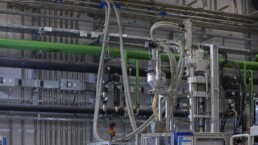The industrial dust collector is one of the technologies used by the plastics industry to ensure efficient production processes and quality results. Dust collectors help both to optimise processing and preserve the characteristics of the plastic granules used as raw material.
In this article, we are going to describe the general operation of a dust collector, focusing on its role in granule conveying and treatment processes. In addition, we will talk about the Vismec dust collectors for plastic granules, their characteristics and advantages for companies.
Dust collector: what is it?
An industrial dust collector is generally a device designed to remove dust particles, residues and other impurities from a variety of materials.
Such materials also include plastic granules. As we said, the presence of dust and other impurities can compromise the quality of the granules and negatively affect the processing result. In other words, residual dust on the granules can cause serious quality problems in the final product, which, for example, may show black spots or flow lines.
Having explained the role of a dust collector in production processes, let us now present its basic operation.
- Material is introduced into the dust collector through a conveyor system.
- The material is exposed to a controlled air flow. Depending on the characteristics of the dust collector, this flow can be combined with the mechanical action of vibrations or centrifugal forces. However, as we will see in the next section, Vismec dust collectors use an alternative and more effective method, in which the presence of compressed air is limited or absent, and the dust removing action implemented by means of static electricity.
- These processes separate dust particles and other impurities from the plastic granules. As a result, the material is ready to be used in various plastic processes.
Besides preserving material quality, the dust collector helps to reduce downtime, lower operating costs and increase productivity and efficiency.
The effectiveness of a dust collector for plastic granules depends on several factors, including the design of the device, the used dedusting system, and the nature of the impurities. Consequently, the careful design of the dust collector with specific technical measures, allows the desired results in terms of quality to be achieved.
In the next section we are going to present in detail the dust collectors offered by Vismec, their features and benefits.
Vismec dust collectors for plastic granules
The dust collectors we offer to plastics processors are designed to guarantee process efficiency and the highest quality result. The operating process we have described takes on specific characteristics in Vismec dust collectors.
In particular, the AIR version, which represents the latest generation of dust collectors, operates as follows:
- in the material supply, virgin or regrind material is conveyed to the dedusting unit;
- the non-contact type air paddle, without contact between the air stream and the granules, conveys a certain amount of material in combination with the sensor signal;
- the high-pressure applied ioniser regulates the static electricity charged in the materials by bringing it below a certain voltage;
- the air amplifier generates a vacuum by emitting a small amount of compressed air; so the force of this vacuum attracts outside air, forming a vortex in the duct;
- the damper (air filler) lowers the vacuum in the duct, supplying outside air, to prevent materials from being easily discharged; it comes into operation when small, light materials are used;
- the light dust contained in the material is separated from the rising air stream.
The dust collector is part of the conveying processes of plastic granules and helps to maintain their effectiveness.
This can be better explained by considering that this type of machinery must always be placed directly on the press in order to obtain a completely dust-free material. In fact, a further conveying of material could generate new residues: the direct installation on the press, on the other hand, preserves the plastic granule from the risk of other contaminations.
As mentioned, one of the most noticeable features of the dust collectors offered by Vismec is the use of static electricity to remove dust from the material, strongly limiting the action of compressed air. Being able to totally remove particles and residues from the granules, a better performance is achieved.
In the air type model, as we have seen above, a small amount of compressed air is still injected into the supply pipes to generate the pneumatic vacuum that enables the granule conveying to start. However, in order to avoid any contamination, even in this case there is no contact between the compressed air and the dedusted material.
Guaranteeing the complete absence of dust in the polymer at the end of the process, our dust collectors are particularly suitable for advanced or high-tech production sectors. These include, for example, the medical sector, the production of spectacle and contact lenses, or optical covers, the consumer electronics sector, such as electronic housings or similar.
Would you like to find out more and learn more about what our dust collectors can offer to your company? Contact the Vismec team!
